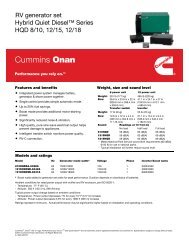Air Brake Manual
Air Brake Manual
Air Brake Manual
You also want an ePaper? Increase the reach of your titles
YUMPU automatically turns print PDFs into web optimized ePapers that Google loves.
Heat-Energy-Traction-Friction<br />
For a vehicle to move along the highway, an internal<br />
combustion engine must convert its heat energy into<br />
mechanical energy. This mechanical energy goes<br />
from the engine to the driving wheel tires by means<br />
of a system of connecting rods, shafts and gears.<br />
The final factor that moves the vehicle is the amount<br />
of traction its tires have on the road surface.<br />
Friction is the force that resists movement between<br />
two surfaces in contact with each other. To stop a<br />
vehicle, the brake shoe linings are forced against<br />
the machined surfaces of the brake drums, creating<br />
friction. This friction produces heat.<br />
The engine converts the energy of heat into the<br />
energy of motion; the brakes must convert this<br />
energy of motion back into the energy of heat. The<br />
friction between brake drums and linings generates<br />
heat while reducing the mechanical energy of the<br />
revolving brake drums and wheels. The heat<br />
produced is absorbed by the metal brake drums,<br />
which dissipate the heat into the atmosphere. The<br />
amount of heat the brake drums can absorb<br />
depends on the thickness of the metal. When<br />
enough friction is created between the brake lining<br />
and the drums, the wheels stop turning. The final<br />
factor that stops the vehicle is the traction between<br />
the tires and the road surface.<br />
If a 200-horsepower engine accelerates a vehicle to<br />
100 km/h in one minute, imagine the power needed<br />
to stop this same vehicle. Also, consider that the<br />
vehicle might have to stop in an emergency in as<br />
little as six seconds (just 1/10 the time it took to<br />
reach 100 km/h).<br />
100 km/h<br />
10X<br />
To stop the vehicle in 1/10 the time it took to<br />
accelerate would require a stopping force of 10<br />
times the acceleration force — the equivalent of<br />
approximately 2,000 horsepower. If the vehicle had<br />
six wheels, each wheel would have to provide 1/6<br />
the braking force. If one or two of the wheels had<br />
brakes that were not properly adjusted, the other<br />
wheels would have to do more than their share of<br />
the braking, and that might be more than their<br />
brakes were constructed to stand. Excessive use of<br />
the brakes would then result in a buildup of heat<br />
greater than the brake drums could absorb and<br />
dissipate. Too much heat results in brake damage<br />
and possible failure.<br />
Most brake linings operate best at around 250°C and<br />
should not exceed 425°C. It’s important to<br />
understand that the power needed to stop generates<br />
heat which could damage the brakes.<br />
<strong>Brake</strong> Drums<br />
250°C<br />
Normal<br />
425°C<br />
Maximum<br />
1100°C<br />
Panic!<br />
6




